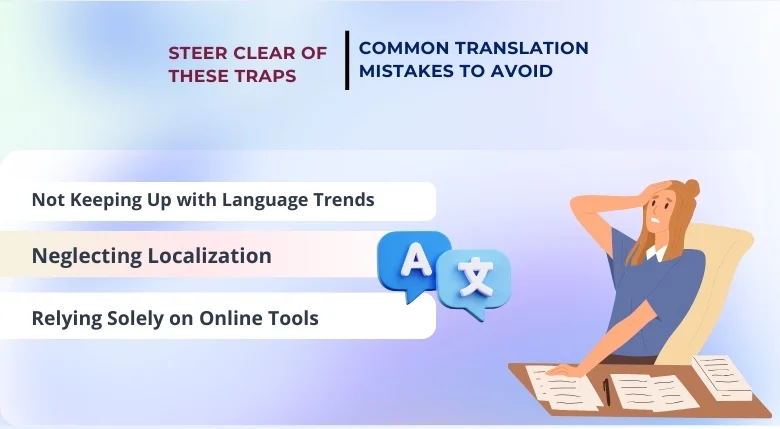
Effective translation is vital in bridging language barriers and facilitating communication across cultures in our increasingly globalized world. This blog post aims to catch some easy-to-spot errors in this process and provide insights on how to avoid them.
The Importance of Accurate Translation
Before going through the common mistakes in translation, it’s important to emphasize the significance of professional translation services. It creates a bridge between different cultures, enabling ideas, products, and services to resonate with a global audience. If failure to perform, it might lead to misunderstandings, damage reputation, and result in financial losses.
Safeguarding Against Obvious Mistakes
☛ Machine Interpretation vs. Human Interpretation: Striking the Right Balance: The rise of tools, such as Google Translate, has made it more accessible to the masses. However, the machine’s accuracy and nuances still need to be improved in comparison to the capabilities of human translators. It’s essential to find the right balance between the two, understanding that while machines can assist, they should not replace the human touch in specific contexts.
☛ Mistranslation of Idioms and Cultural References: One of the most common and easily noticeable mistakes is the mistranslation of idiomatic expressions and cultural references. These phrases often have no direct counterparts in the target language, making them challenging to translate accurately. Attempting a literal interpretation can lead to confusion or unintentional humour. Understanding the cultural context of the source and target languages is essential to avoid this mistake.
☛ Ignoring Context and Tone: Inaccurate translation can result from not considering the context and tone of the source text. Words may have many meanings depending on the context in which they are used. Failure to discern the style, whether formal, informal, humorous, or severe, can lead to the wrong translation of the message. Thoroughly analyzing the context is essential to delivering an accurate translation. Moreover, you should also know about the Style Guide for Translation
☛ Neglecting the Importance of Proofreading and Editing: Proofreading and editing are critical steps in the translation work. A simple typographical error or grammar mistake can change the entire meaning of a sentence. Proofreading ensures the word task is grammatically correct and free from typographical errors, providing a polished final product.
☛ Word-for-Word Paraphrase: One of the most common mistakes, especially among novice translators, is attempting a word-for-word translation. This approach ignores the nuances and structure of the target language, leading to awkward phrasing and, at times, incoherent sentences. A successful translation should convey the intended message in a way that feels natural to the native speakers of the target language.
☛ Neglecting Localization: Localization is an essential aspect, especially regarding marketing and branding. Failing to consider the cultural and social norms of the target audience can result in insensitivity or even offence. Adapting the translations to the target audience’s local customs, preferences, and cultural sensibilities is essential.
☛ Overlooking the Importance of Professionalism: The translation industry is vast and diverse, with various specialization areas, such as legal, medical, technical, etc. Each of these fields demands a high level of expertise and industry-specific knowledge. Using a professional translator with expertise in the relevant domain is critical to ensuring accuracy and quality.
☛ Relying Solely on Online Tools: While online tools can assist you, they should not be the primary source for essential or complex translations. These tools cannot understand nuances, context, or culture and should be used cautiously for critical work.
☛ Failure to Communicate with the Translator: Effective communication between the client and the translator is essential for a successful project. The client should provide the translator with clear guidelines, reference materials, and context. Regular feedback and discussion with the translator can help resolve ambiguities and ensure the final translation meets the client’s expectations.
☛ Rushing the Translation Process: In a fast-paced world, there’s often pressure to complete interpretation projects quickly and rushing it can lead to mistakes and inaccuracies. Translators need time to research, translate, and review their work to ensure a high-quality output. Cutting corners to meet tight deadlines can result in costly mistakes.
☛ Inadequate Research and Reference Materials: An expert working in this industry must invest time in research and access appropriate reference materials to produce accurate work. Inadequate research can lead to omissions of critical information, affecting the overall quality of the translation.
☛ Neglecting the Revision Process: After the initial translation, a thorough revision is essential. This step helps identify and correct errors, ensuring the final document is polished and accurate. Neglecting modification can lead to mistakes that may have been avoided with proper proofreading and editing.Don’t ever neglect localization, always get it from an expert localization services agency.
☛ Not Keeping Up with Language Trends: Languages constantly evolve, with new words and phrases regularly entering the lexicon. Failing to keep up with language trends can result in outdated or incorrect translations. Translators should stay updated and continuously learn to maintain their language proficiency.
☛ Disregarding Regional Variations: Languages can have significant regional variations in vocabulary, pronunciation, and grammar. A failure to account for these variations can result in a translation not well-received or understood by the target audience. Appropriate regional dialect or terminology is essential when translating for a specific region.
Somya Translators: A Home of Multilingual Translation
Translation is both an art and a science. It requires linguistic expertise, cultural understanding, and a dedication to accurately conveying meaning, which Somya Translators offers. Avoiding the common faults discussed in this blog post is essential for anyone involved in the translation process. Recognizing these pitfalls and taking the necessary precautions can enhance cross-cultural communication and ensure that translations achieve their intended purpose. Always remember that accurate and culturally sensitive work is the key to building connections and fostering understanding in our diverse and interconnected world.
To have more support, solve your queries, and manifest to grow better- you can easily contact us- at +91-9990094796 and get a free quote request.







